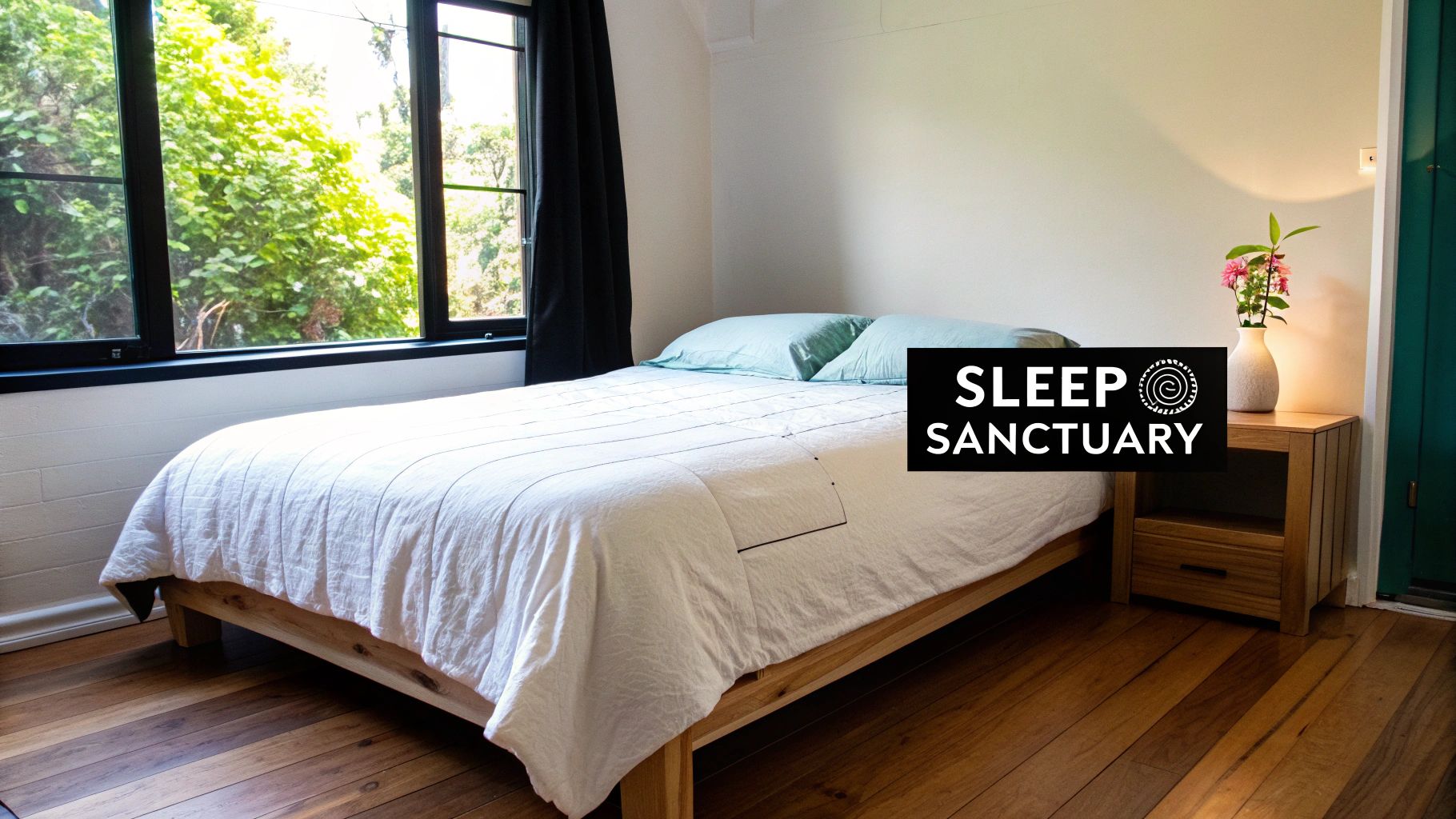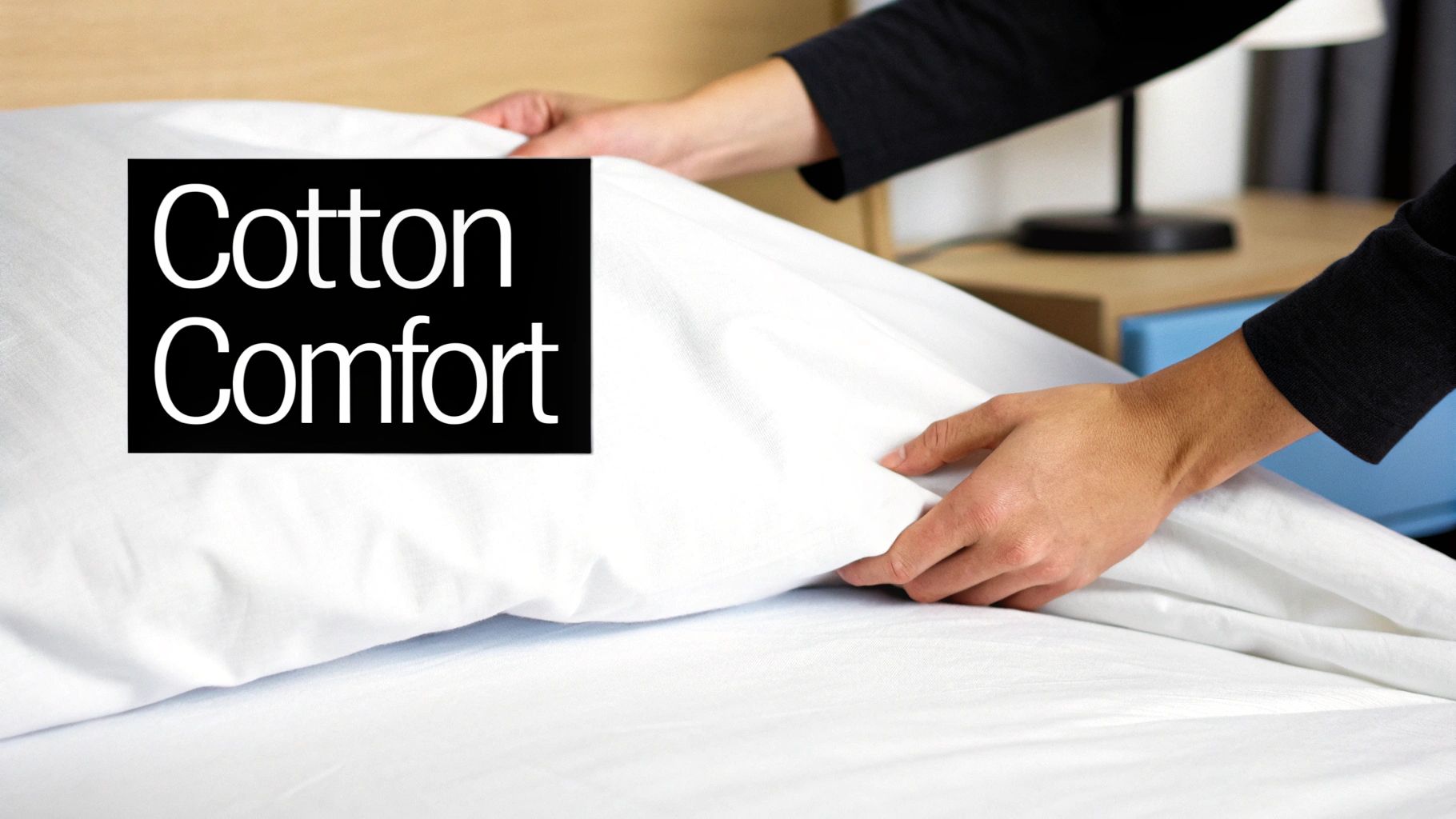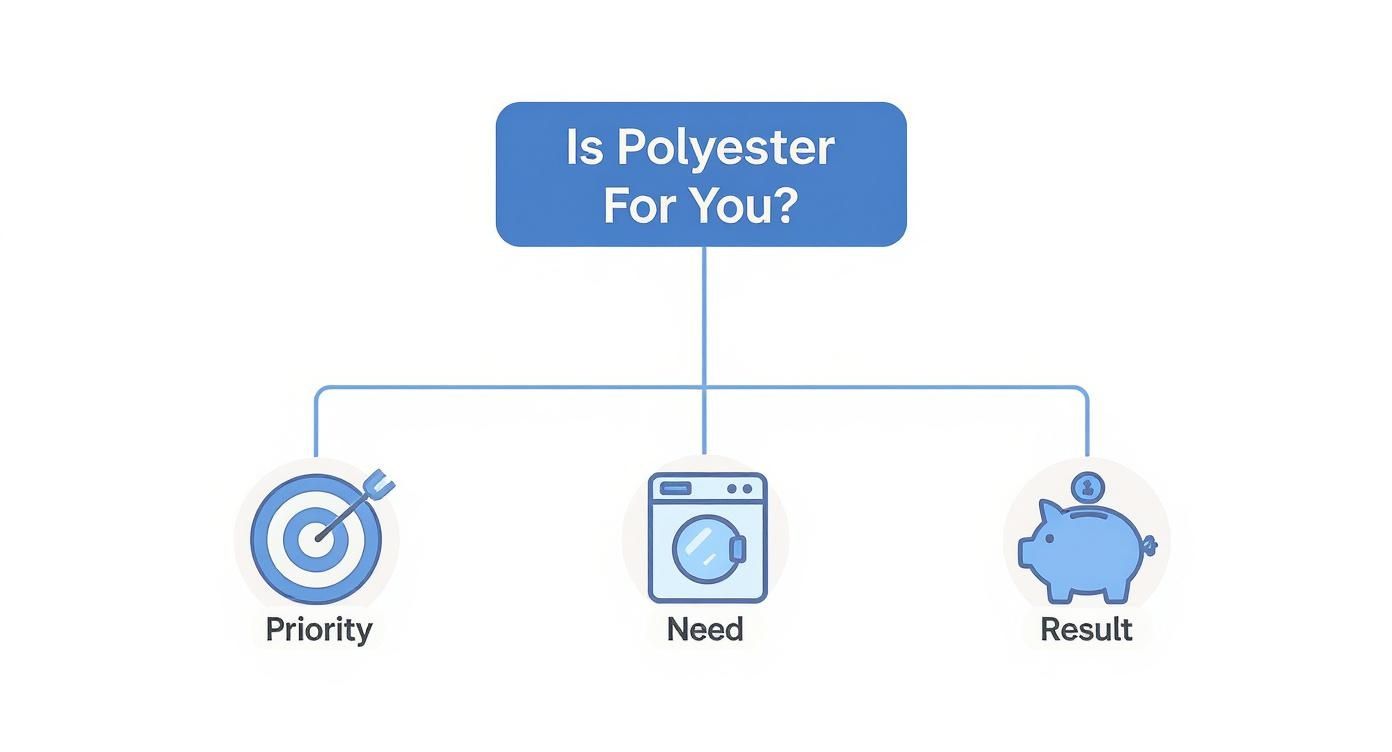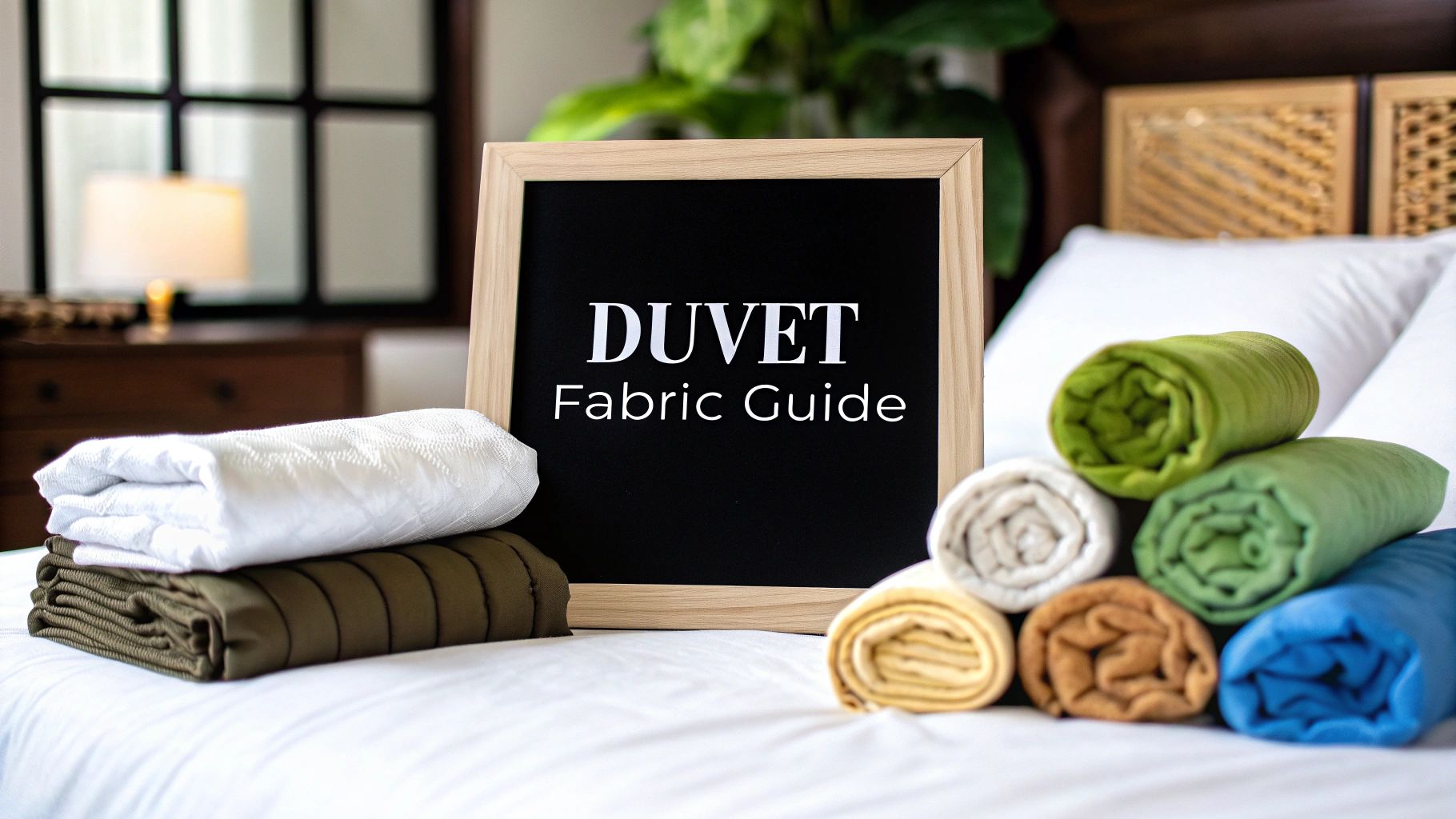When it comes to choosing the best fabric for a duvet cover, it really boils down to what feels right for you. That said, you can rarely go wrong with a breathable, durable, and soft cotton, it is a consistent favourite for a reason. If you tend to get warm at night or love that effortlessly relaxed look, linen is another fantastic choice that is brilliant at drawing away moisture.
Your Guide to a Better Night's Sleep
Picking the right fabric for your duvet cover is one of the easiest yet most important changes you can make to improve your sleep. It is about so much more than just a colour or pattern. The material touching your skin all night directly affects how comfortable, cool, and ultimately, how rested you feel.
This guide is designed to cut through the confusing terms and help you find the perfect match for your bed.
We will walk through the most popular options out there, from the classic, crisp feel of high quality cotton to the laid back luxury of pure linen. We will look at how each one performs in the real world, whether you are a warm sleeper, have sensitive skin, or just want to make your bedroom feel like a five star hotel.
To get us started, let us take a quick look at the main contenders.

A Quick Look at Popular Duvet Cover Fabrics
This little comparison table helps you see the key features of common duvet cover materials at a glance, making it easier to spot which one might be the best fit for your bedroom.
| Fabric Type | Best For | Feel | Price Range |
|---|---|---|---|
| Cotton | All round comfort and breathability | Soft, crisp, or silky, depending on weave | £-£££ |
| Linen | Warm sleepers and a relaxed, natural style | Textured, airy, and softening over time | ££-£££ |
| Bamboo | Sensitive skin and sustainable luxury | Silky smooth and cool to the touch | ££-£££ |
| Microfibre | Budget friendly and easy care options | Ultra soft, velvety, and lightweight | £-££ |
Each of these fabrics brings something unique to the bed. Now, let us dive a bit deeper into what makes each one special.
Cotton: The Timeless and Trusted Classic
When you think of comfortable bedding, what comes to mind? For most of us, it is cotton. It is the go to choice for a reason, offering a reliable and comforting feel that works for just about everyone, all year round. Its natural fibres let your skin breathe, which is brilliant for regulating your temperature and helping you get a more peaceful, sweat free night.
This incredible breathability is precisely why cotton is the most popular fabric for duvet covers here in the UK. In fact, it completely dominates the market. Well over 60% of British households prioritise cotton for its natural feel and lasting quality, making it the undisputed champion of home textiles.
On top of that, cotton is celebrated for its durability. A well made cotton duvet cover can easily stand up to years of regular washing. If anything, it often gets softer and more inviting with every spin.

Different Weaves for Different Sleepers
Here is a little industry secret, not all cotton is created equal. The real magic is in the weave. How the threads are woven together completely transforms the final fabric, meaning there is a perfect cotton out there for your personal comfort.
-
Percale: Imagine a simple, grid like pattern. This weave creates a fabric that feels light, crisp, and cool to the touch. If you love that fresh hotel bed feeling, percale is probably the best fabric for a duvet cover for you. It is a real game changer in warmer months or for anyone who tends to get warm at night.
-
Sateen: Using a different weaving technique, sateen offers a silkier, smoother finish with a lovely, subtle sheen. It drapes beautifully over the bed and feels a little warmer and cosier against the skin. It is a wonderful choice if you want a touch of everyday luxury or tend to feel the cold.
It is not just about the weave, though. The type of cotton plant itself plays a massive part in the final quality. Long staple cottons, like Egyptian or Pima, have longer, stronger fibres. This results in fabric that is exceptionally soft, smooth, and much more resistant to pilling. For anyone looking to invest in real, lasting quality, exploring the benefits of organic cotton bed sheets can offer even more insight.
Linen and Bamboo: Sustainable and Soothing Choices
If you are looking to move beyond traditional cotton, linen and bamboo are fantastic alternatives that blend eco conscious living with pure comfort. They have really become popular in recent years, especially for people who want their bedding to feel as good as it looks.

This move towards greener materials is not just a niche trend. While cotton is still king, a growing number of UK shoppers, around 10-15%, are now deliberately choosing sustainable options like linen and bamboo for their homes. It is a choice driven by both environmental awareness and a desire for personal wellbeing.
The Relaxed Charm of Linen
There is something effortlessly stylish about linen. It has that perfectly imperfect, slightly crumpled look that just creates a relaxed style. But its real magic is in how it feels and performs.
- Exceptionally Breathable: The flax fibres that make up linen are hollow, which allows air to move through the fabric incredibly well. This makes it one of the most breathable materials you can find.
- A Warm Sleeper's Dream: It is brilliant at drawing moisture away from your body, keeping you feeling cool and dry even on those stuffy summer nights.
- Gets Better with Age: Here is the best part. Unlike fabrics that wear out over time, linen actually gets softer and more comfortable with every wash.
Linen is a fantastic investment for year round comfort. It feels crisp and cool in the summer, yet has a comforting weight for the winter. If you are trying to decide, our guide on the differences between linen vs cotton goes into even more detail.
The Silky Softness of Bamboo
For those who dream of a smoother, more luxurious feel, bamboo is an incredible choice. Fabric made from bamboo viscose is unbelievably silky against the skin, often being compared to high end cotton or even silk.
Its fibres are naturally smooth and round without any sharp spurs, which means it is exceptionally gentle on the skin. This quality makes it a top contender for the best fabric for a duvet cover if you have allergies or sensitivities.
On top of its luxurious feel, bamboo also shares many of linen's best qualities. It is highly breathable, great at drawing away moisture, and naturally hypoallergenic, creating a healthy and soothing sleep environment that feels like a gentle hug all night long.
Microfibre and Polyester: Practical and Budget Friendly
When your top priorities are practicality, durability, and a friendly price tag, you really cannot go wrong with man made fabrics like microfibre and polyester. They are engineered for modern life, making them a fantastic choice for busy households, children's rooms, or anyone who needs bedding that can keep up.
The real appeal of these fabrics is just how easy they are to live with. They resist wrinkles beautifully, so your bed looks neat with minimal fuss. Plus, they are incredibly simple to care for, washing well and drying in a fraction of the time it takes cotton or linen.
Why Choose a Man Made Fabric?
These materials are designed to be tough and long lasting. They hold their colour through countless washes and are far less likely to shrink or lose their shape over time. This is what makes them such a reliable and cost effective option for everyday use.
- Velvety Softness: Do not let the synthetic nature fool you. Microfibre is made from ultra fine threads, even finer than silk, which gives it a surprisingly soft and velvety feel against the skin.
- Ideal for Allergies: The tight weave of microfibre makes it difficult for dust mites and other allergens to settle in, offering a more comfortable night for those with sensitivities.
- Unbeatable Value: You can get a wonderfully soft and durable duvet cover without the hefty price tag, making it perfect for spare rooms or university accommodation.
The main trade off with polyester and microfibre is breathability. Unlike natural fibres like cotton or linen, they can sometimes trap heat. If you tend to sleep warm, this is something to consider, but for many, the practical benefits make it the best fabric for a duvet cover choice.
For more insights into different bedding materials, you might be interested in our guide on the best material for bed sheets, which explores comfort and practicality further.
How to Find the Perfect Fabric for You
Now that we have covered the main players on the bedding scene, let us get personal. Finding the right duvet cover fabric is not about what is trendy, it is about what works for you.
The secret is simply matching the material to your own sleep habits and lifestyle. A few simple questions can point you straight to the perfect bedding for a blissful night's sleep.
Consider Your Comfort Priorities
First up, let us talk temperature. Are you someone who kicks off the covers in the middle of the night, or do you find yourself shivering and reaching for an extra blanket?
If you are a notoriously warm sleeper, you will want something breathable that lets air move freely. Fabrics like cool, crisp linen or a classic cotton percale are absolute game changers for keeping you comfortable. On the flip side, if you are always cold, the silky smooth feel of cotton sateen or the plushness of microfibre can offer that extra touch of snug warmth you are looking for.
And for those with sensitive skin or allergies, a naturally hypoallergenic choice like bamboo can be a real relief, helping you wake up refreshed and irritation free.
This decision tree gives you a great visual on how to narrow down your options, especially when practical needs come into play.

As you can see, when things like durability, easy washing, and budget are top of your list, polyester quickly emerges as a smart, practical solution.
Your lifestyle is a huge factor, too. If you dread laundry day and just want bedding that is simple to care for, you really cannot beat microfibre. It is known for being low maintenance, quick drying, and wrinkle resistant.
While people often get fixated on numbers, it is worth noting that the weave and feel of the fabric are just as crucial as the thread count. If you would like to dive deeper into that topic, you can explore our guide on the best thread count for sheets. In the UK market, where a significant 70% of bedding sales fall into the mid range price bracket, finding that sweet spot between quality and cost is what most of us are after. You can find more insights on UK home textile trends on verifiedmarketresearch.com.
Matching Fabric to Your Sleep Style
To make it even simpler, this table breaks down which fabric is likely your best bet based on common sleep styles and needs.
| If You Are... | Your Best Fabric Choice | Why It Works |
|---|---|---|
| A Warm Sleeper | Linen or Cotton Percale | These fabrics are highly breathable, allowing air to circulate and draw away moisture, keeping you cool all night long. |
| Always Feeling Cold | Cotton Sateen or Microfibre | Their tighter weaves and softer finishes trap a little more body heat, providing a cosy and warm sleeping environment. |
| Prone to Allergies | Bamboo or Silk | Naturally hypoallergenic and resistant to dust mites, these materials are gentle on sensitive skin and help reduce irritation. |
| On a Tight Budget | Microfibre (Polyester) | It offers impressive durability and softness for a fraction of the cost of natural fibres, making it a great value choice. |
| Looking for Luxury | Silk or High Quality Cotton | Nothing quite beats the indulgent feel of pure silk or a premium long staple cotton like Egyptian for a five star hotel experience. |
| In Need of Low Maintenance Bedding | Microfibre or Cotton Blends | These materials are built for real life, they resist wrinkles, wash easily, and dry quickly, saving you time and effort. |
Hopefully, seeing it laid out like this helps you pinpoint exactly what you should be looking for. Your perfect duvet cover is out there.
Common Questions About Duvet Covers
Let us tackle some of the common questions that pop up when you are choosing a new duvet cover. Getting these details right will help you feel much more confident in your final decision.
Does Thread Count Really Matter That Much?
It is easy to get caught up in the numbers, but a high thread count is not the most important factor. The quality of the yarn and the weave itself often play a much bigger role in how the fabric actually feels.
Think of it this way, a beautifully made 300 thread count cover woven from high quality, long staple cotton can feel miles more luxurious than a 1,000 thread count cover made from inferior, shorter fibres. So, instead of focusing only on the thread count, look at the quality of the material as a whole.
How Often Should I Wash My Duvet Cover?
As a general guideline, washing your duvet cover every one to two weeks keeps your bed feeling fresh and hygienic.
If you suffer from allergies or have a furry friend sharing your bed, you might want to stick to a weekly wash. Always give the care label a quick check first, as more delicate materials like silk or certain linens will need a gentler touch.
What Is the Difference Between Percale and Sateen?
Percale and sateen are all about the weave. They are both typically made from cotton, but how the threads are woven together creates a completely different experience.
- Percale: This is a simple, classic one thread over, one thread under weave. The result is a light, crisp fabric with a matt finish that feels wonderfully cool against the skin. It is a fantastic choice for warm sleepers.
- Sateen: This weave is a bit more complex, usually one thread under and three over. This technique exposes more of the thread's surface, giving sateen its signature silky smooth feel and subtle, elegant sheen. It tends to be a little warmer and drapes beautifully.
A duvet cover is essentially a large, protective pillowcase for your duvet insert. You can easily remove it for washing, unlike a comforter, which is a single stitched piece. This difference is explained further in our guide on what duvets and covers are, helping you choose the best option for your home.



Share:
A Guide to Organic Cotton Bed Sheets
Comforter vs Duvet: Which is Right for You? A Quick Guide